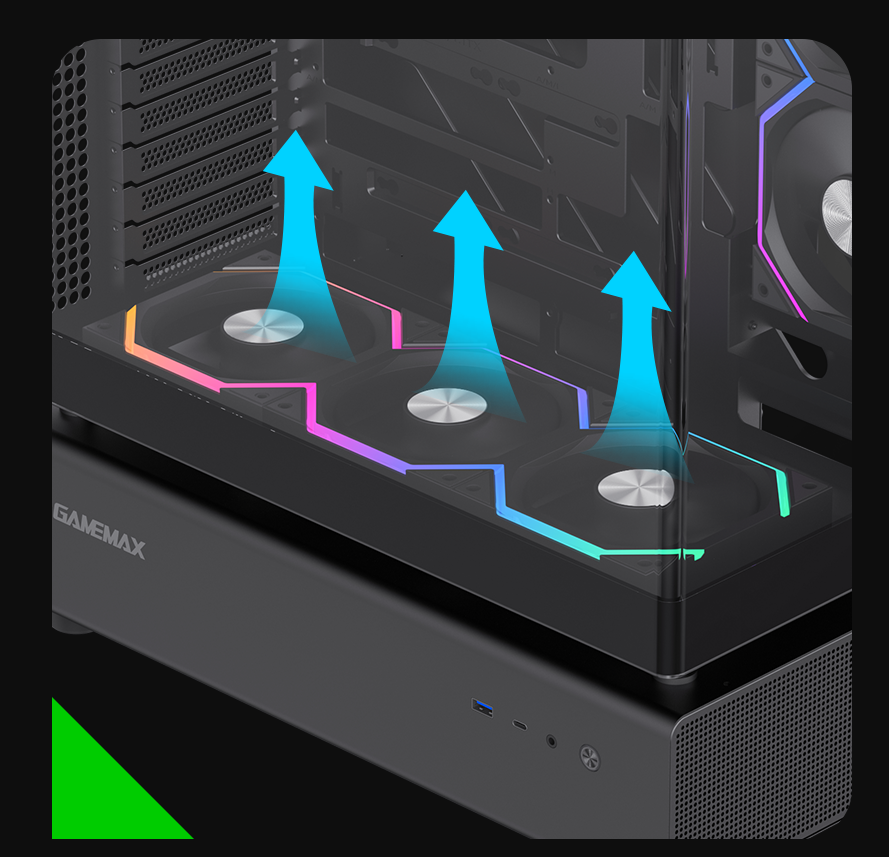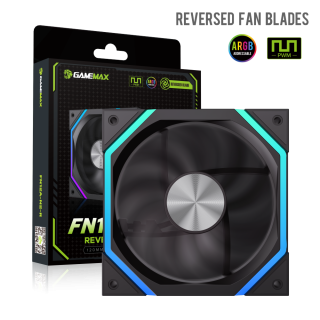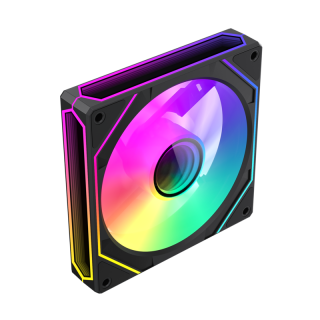In the realm of PC hardware cooling, the airflow direction and installation position of fans often dictate the overall cooling efficiency of the system. Traditional fans use forward-facing blades to "push" air into or out of the chassis, but in special areas like power supply shrouds or the bottom of the chassis, the airflow direction of conventional fans may fail to effectively cover cooling blind spots. The emergence of reverse fans is precisely aimed at solving these heat dissipation challenges in "dead zones." This article, combined with GameMax's reverse fan product line, analyzes how this innovative design reshapes the logic of chassis cooling.

The core feature of reverse fans lies in the special design of blade angles and rotation direction, which reverses the airflow direction compared to traditional fans. While traditional fans typically "draw air in and expel it forward," reverse fans use inverted blade structures to intake air from the back of the fan and exhaust it from the front. This design offers significant advantages in the following scenarios:
Power Supply Shroud/Bottom Intake:
Many chassis feature independent power supply chambers with partitioned designs. When traditional fans are installed at the bottom, airflow is easily blocked by the power supply shroud, reducing intake efficiency. Reverse fans can be directly mounted under the power supply shroud or at the bottom of the chassis, drawing cold air from below through inverse airflow to precisely cool the power supply and surrounding components, preventing heat accumulation.
Liquid Cooler Radiator Assistance:
When radiators are installed at the top or front of the chassis, reverse fans can act as the "intake" end, working with forward fans to create bidirectional convection and enhance radiator cooling efficiency—especially suitable for chassis with strong sealing.
Vertical Airflow Optimization:
In compact ITX chassis or vertical airflow designs, reverse fans flexibly adjust airflow direction to resolve turbulence caused by limited space, ensuring rapid heat dissipation from core components like the CPU and GPU.
GameMax offers multiple reverse fan models tailored to different cooling scenarios, combining high-efficiency heat dissipation, silent design, and customizable lighting effects. Here’s an analysis of the core products:

Inverse Airflow Design: Customized for power supply shrouds and chassis bottoms, the reversed blades boost intake efficiency, eliminating cooling blind spots in enclosed areas.
Smart Speed Control & Silence: Supports PWM intelligent temperature control with a speed range of 800–1600±10% RPM. Equipped with hydraulic bearings, noise is minimized to 25–30dB(A), balancing performance and quiet operation.
ARGB Lighting: Full-color addressable RGB effects with an infinite mirror ring design, supporting motherboard synchronization for immersive lighting—ideal for showcasing in side-panel transparent chassis.

Dual Cooling & Visual Experience: Combines central infinite mirror lighting with inverse airflow, enhancing air intake for power supply chambers while adding layered RGB effects to the chassis interior.
Long-Life Hydraulic Bearings: Uses durable hydraulic bearings with a lifespan of over 40,000 hours, delivering high static pressure at low speeds (1.98mm H2O)—perfect for high-load scenarios requiring stable cooling.
Size Compatibility: Prioritize 120mm or 140mm sizes matching your chassis fan slots (GameMax reverse fans are mainly 120mm, compatible with most mainstream chassis).
Airflow Requirements:
High Static Pressure Scenarios (e.g., power supply shrouds, dense fins): Focus on "static pressure" parameters (e.g., GameMax reverse fans reach 1.83–1.98mm H2O) to ensure airflow penetrates obstructions.
Silence Priority: Choose models with hydraulic or rifle bearings (noise ≤30dB(A)) and PWM temperature control for automatic speed reduction under low load.
Lighting & Expandability:
For personalized lighting, opt for ARGB models (addressable control, e.g., FN12A series); non-LED versions (e.g., GMX-WFBK-PWM series) are ideal for pure cooling needs.
For multi-fan setups, check hub compatibility (some GameMax kits include ARGB Hubs supporting 9+ fans in series).
Airflow Markings: Reverse fans usually have "INTAKE" labels or arrows indicating the air intake direction (rear of the fan). Ensure blade rotation aligns with the chassis airflow (e.g., bottom/front fans as intake, top/rear as exhaust).
Combination Strategy: Pair with forward fans to create a three-dimensional airflow pattern ("front intake, rear exhaust; bottom intake, top exhaust") and avoid turbulence from single reverse fans.
Cable Management: Utilize the hub function in reverse fan kits (e.g., KF300R BK) to reduce motherboard port usage and keep internal wiring tidy.
GameMax reverse fans solve the cooling pain points of traditional fans in special areas through inverse engineering, seamlessly integrating functionality and playability. Whether you’re a hardcore gamer ultimate cooling or a MOD enthusiast loving "light pollution," reverse fans offer more possibilities for chassis airflow design. Choosing the right reverse fan not only optimizes hardware temperature performance but also enables personalized builds with flexible installation and lighting—combining performance and aesthetics.

• Quiet Operation: With a hydraulic bearing design, it operates at just 33.7dB(A) for a quiet environment.
• High Air Pressure: Delivers 1.98mm H2O air pressure, ensuring stable temperature control for your components.
• PWM Smart Speed Control: The 4-pin PWM interface enables precise speed adjustment for optimized performance and noise.
• RGB Compatibility: Supports 3-pin Aura RGB lighting synchronization for an enhanced gaming atmosphere.
• Long Lifespan: Offers up to 30,000 hours of reliable use.
• Multiple Interface Compatibility: Includes various connectors for broad motherboard and power system compatibility.

GameMax FN12A-S8I-R, Reverse 120mm Black frame ARGB Fan -Reverse Fan Blade for Power Supply Shroud /Bottom plate of Case for Air Intakes!
• 【Intelligent Speed Control】120mm full function ARGB PWM fans
• The intelligent temperature controls the speed at 800~1600±10% RPM, by linking to the motherboard PWM 4pin socket, so the fan speed auto controlled and keeps the fans quiet
• These fans are 3pin 5v ARGB connectors that connect with ARGB control HUB one by one
• 【Inner And Outer Light】Addressable RGB LEDs can be controlled by ARGB remote controller, Multiple ARGB light modes and speeds, provide colorful streamer lighting effects
• creating a practical and beautiful cooling system
• You also can turn on / off the fan light effect and switch the fan hub ARGB signal to the motherboard 5V ARGB port by AURA Sync Mode
• 【Shockproof Design】The fan frame is fixed on both sides with 8 pieces of shock-absorbing rubber pads
• The rubber soft material which is not easy to peel off has a good shock-absorbing effect, which can make the internal operation of the computer case stable and reduce the noise output between the fan and the computer case
• The maximum noise of the fan is only 31.21dBA
• 【Reverse Blade of Fan】 Reverse Fan Blade for Power Supply Shroud /Bottom plate of Case for Air Intakes, to additional increase airflow from bottom to vertical chassis design type.